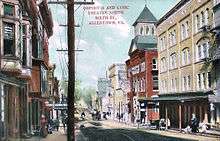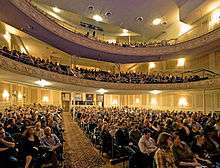Miller Symphony Hall
 | |
| Former names | Lyric Theatre, Allentown Symphony Hall |
|---|---|
| Location |
23 North 6th St. Allentown, Pennsylvania United States |
| Owner | Allentown Symphony Orchestra |
| Type | Concert hall |
| Seating type | Reserved |
| Capacity | 1,200 |
| Construction | |
| Built | 1896-1899 |
| Website | |
| www.millersymphonyhall.com | |
The historic, 1200-seat Miller Symphony Hall, formerly known as the Allentown Symphony Hall, is the premier performing arts facility in Allentown, the largest city in Pennsylvania's Lehigh Valley.
Allentown Symphony Association
The Mission of the Allentown Symphony Association is "to provide a first-class symphony orchestra and Hall, quality performing arts, and cultural education in partnership with the community."
The theater maintains a full production schedule of non-orchestral performances, including the new Symphony Hall Pops Series, Jazz Cabaret Series, Backstage Chamber Series, Musical Treasure Chest series for small children and their families, and a variety of Special Events.
In addition to the Allentown Symphony Orchestra, Miller Symphony Hall also serves as home to the Pennsylvania Sinfonia, Community Concerts of Allentown, the Allentown Band, the Community Music School of the Lehigh Valley and the annual Nutcracker performance of Repertory Dance Theatre.
History
Origins

Miller Symphony Hall's heritage dates back to 1817 when Northampton Town got its first farmer's market on Center Square. It was a wood and stone building. In 1848 that building was consumed by fire when most of the Allentown Central Business District burned down. It was rebuilt in 1859 at the corner of Church Street and Linden. In the mid 1890s, a new Central Market was built at the northeast corner of Sixth and Court Streets. However, it was not successful economically.[1] By the late 1890s concerts were being held there and in 1899, the structure was converted to a theater by the firm of J.B. McElfatrick.[2] The Lyric was designed as a legitimate theater for plays. Its name came about as the result of a contest, a five dollar gold piece being offered for the best choice.[3]
Lyric Theater
The Lyric opened with a comic opera production based on the life of 18th century Prussian King Frederick the Great.[3] The theater offered vaudeville, operas, plays, dramatic skits, minstrel shows, films and concerts,[2] and also became one of the leading burlesque halls in the United States. On December 1, 1910, French stage actress Sarah Bernhardt made a one-night appearance at the Lyric.[4] In 1912, it was the site of speeches by Theodore Roosevelt, Woodrow Wilson and Booker T. Washington.[5] Close to the Lyric at 35 North Sixth was the Orpheum Theater, which opened in 1906. While the Lyric presented primarily stage plays, the Orpheum was the first major vaudeville theater in Allentown. It presented variety shows, it mixed jugglers, song-and-dance teams and acrobats, comedians and other live performers.[6]

During World War I, Allentown was the home of a large Army training camp, Camp Crane, where thousands of recruits were indoctrinated into the military as ambulance drivers before being sent overseas to France. The Lyric, although primarily a stage theater, was adapted to show silent films to entertain the troops that came into the city for recreation.[7][8] Oliver "Ollie" Gernert, the treasurer of the Lyric, took note that when the Lyric showed a movie, it was packed with soldiers, but when it presented a stage play, many seats were empty. Gernert believed that a cinema-only theater would be extremely profitable, and if it owned by someone who worked for the Lyric, there would be no conflict of interest as the Lyric could continue to present stage shows.[8] The Orpheum Theater, located next to the Lyric at Sixth and Linden, was primarily a vaudeville theater. It was decided to construct a new cinema-only theater and return the Lyric to a stage theater only. The cinema, known as "The Stand" was erected during the summer of 1917 on North Eighth Street, and it opened to a full auditorium on 8 October of that year.[8]
By the early 1920s the Orpheum Theater was converted into a cinema known as the State Theater, and most of the Vaudeville acts that performed there began to perform at the Lyric.[6] The building was renovated and sported a new neo-classical facade, done by Allentown’s first Jewish architect, David Levy, and had become one of the nation’s leading “tryout” theaters, a place where new stage shows appeared before being taken to Broadway.[3] The Marx Brothers debuted the musical revue I'll Say She Is at the Lyric in 1923.[9] The show would go on for a long run in Philadelphia, and became a hit on Broadway.[10] In 1926 the Lyric stepped briefly into an international spotlight when it became the first theater in America to show “Ashes of Love,” a play written by a titled English lady, Vera Countess of Cathcart, whose scandalous divorce led to her briefly being kept out of the U.S. on grounds of “moral turpitude. [3]
With the advent of the Great Depression, the fortunes of the theater seriously declined. The number of new plays on the traveling theater tryout circuit was reduced dramatically. There were not enough plays to keep the theater running full time. Empty seats in thee theater and an increasing number of nights without a show to present forced the theater managers to book other sorts of entertainment unlike those they had run before. As a result, Boxing matches and appearances by marginal entertainers such as Busty Russell and Ding Dong Bell, that suggested their talents were more physical than strictly theatrical, were considered all it was good for. Prize fights and burlesque strip shows may not have been the most decorous forms of entertainment, but they “filled the hall,” as the saying went, and paid the rent. However, by the end of World War II, it seemed that the Lyric Theater had its best days behind it. [3]
In the late 1940s, the Lyric became the home of the Allentown Symphony Orchestra and the Allentown Community Concert Association. About 4,000 to 5,000 local concertgoers attended concerts at the Lyric from 1945 to 1952.[2] In addition to the Symphony concerts, burlesque shows kept bringing in the crowds. The seemingly incongruous relationship was profiled in Philadelphia Inquirer Magazine. “There they have burlesque every Saturday night — in Symphony Hall. … It’s doubtless the only symphony in the country that is partly supported by burlesque.”[11]
Allentown Symphony Hall

However, by the late 1950s, the Lyric was losing money and its owners, I. Hirst Enterprises, Inc. planned to close the theater and sell the property. Park & Shop Enterprises, an Allentown Parking lot firm which had purchased the adjacent State (formerly the Orpheum) theater in 1953 and tore it down, converting the land into parking space for shoppers going to the Retail District of Allentown on Hamilton Street. Seeing the Lyric was for sale, they approached Hirst Enterprises to buy the Lyric. [3] However, just before the sale to Park & Shop was confirmed, Donald and Sam Miller, the owners of the Morning Call Newspaper, offered Hirst Enterprises to buy the theater. The Millers put together a plan on June 2d, 1959 to the Allentown Symphony Association to purchase the building for the orchestra as a dedicated concert hall. [2] Financing was secured and approved with the First National Bank of Allentown for the purchase. The Lyric Theater was purchased on July 14, 1959. Later, the building was renamed Allentown Symphony Hall. [2]

With the purchase of the theater by the Millers, the burlesque shows at the Lyric ended. Allentown Symphony Hall became primarily a venue for classical music concerts and stage play productions. It is also used by the Allentown School District for its student classical music students and also for other events such as ballet and Jazz shows.
In 1987, the symphony association, stuck with a deteriorating building and a hefty debt, set a course for the restoration of the one-time burlesque house by undertaking its own fund-raising program and forgoing an offer to sell the building. A fund-raising effort resulted in $10 million being raised by the Allentown Symphony Association from public and private sources to improve the Hall.[2] Restoration and renovation at Symphony Hall began in 1991 and in 2006, the renovation project was completed that repaired the exterior and roof, upgraded patron seating and lobby areas, created rehearsal, office and reception spaces, and added an entire wing with new lobby, teaching and dressing room spaces. In addition, the renovation project completed an upgrade of the Symphony Hall stage and constructed a new acoustical shell. [2] A second phase of renovations, paid for as part of its $6 million 60th anniversary fundraising campaign held in 2011 replaced and reinforced the main stage floor and added doors between the inner lobby and the theater. Ongoing renovations will replace seating on the third-level balcony and improve and modernize the backstage area and lighting.[2]
Miller Symphony Hall
In recognition and appreciation for the Miller family, November 10, 2012, the Board of the Allentown Symphony Association changed the name to Miller Symphony Hall.[12]
See also
References
- ↑ Allentown Farmers Market is hallowed by Pennsylvania German tradition, Frank Whelan, WFMZ, 24 February 2012
- 1 2 3 4 5 6 7 8 Lathrop, Marie (August 12, 1991), "Rebuilders Find 90 Years Of History At Symphony Hall.", The Morning Call, pp. B.01
- 1 2 3 4 5 6 History's Headlines: Allentown's Miller Symphony Hall continues to make history Frank Whelan, WFMZ, 30 November 2012
- ↑ Whelan, Frank (April 18, 1999), "Let Us Entertain You Decade Sees Movies Rise And Vaudeville Decline Defining America: The 1910s A Decade Of Immigration.", The Morning Call, pp. E.01
- ↑ "Historical Allentown". Retrieved 2007-05-27.
- 1 2 Frank Whelan. "1Let Us Entertain You Decade Sees Movies Rise And Vaudeville Decline Defining America: The 1910s A Decade Of Immigration". The Morning Call newspaper, Allentown, Pennsylvania.
- ↑ Hellerich, Mahlon H, and Pennsylvania) Lehigh County Historical Society Allentown. Allentown, 1762–1987 : a 225-year history. Allentown, Pennsylvania: Lehigh County Historical Society, 1987
- 1 2 3 Historic 1917-era theater gets a new owner in Allentown, Pa.
- ↑ Kohl, John Y. (April 9, 1999), "'Who's Who' Of Show Business Played The Orpheum In Allentown.", The Morning Call, pp. E.01
- ↑ Marcovitz, Hal (September 6, 1990), "Collector Won't Let Laughter Fade Away.", The Morning Call, pp. N.01
- ↑ Burlesque is back - Artistic community sees a resurgence in bygone entertainment, Lehigh Valley Live, By Kelly Huth | The Express-Times on February 26, 2012
- ↑ "An Historic Change Has Been Made at Allentown Symphony Hall".
Coordinates: 40°36′14″N 75°28′11″W / 40.603753°N 75.46971°W